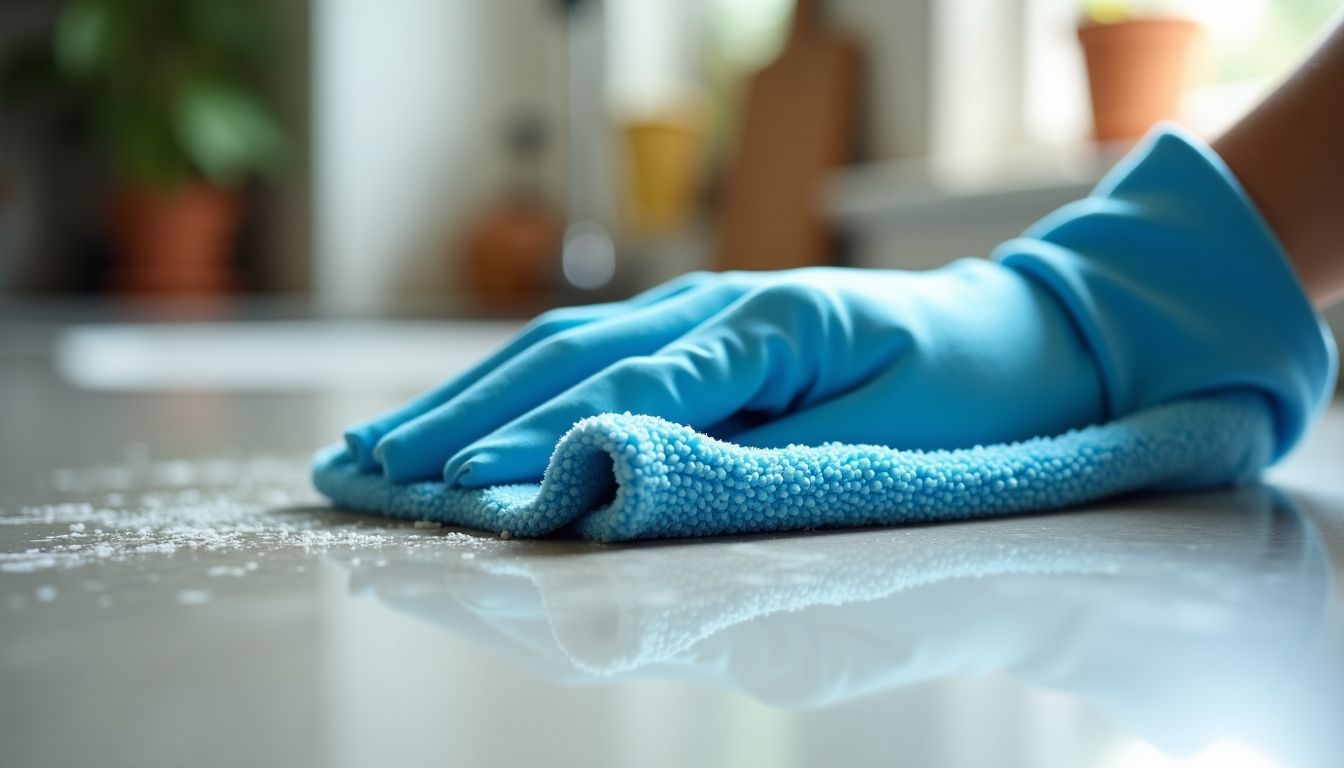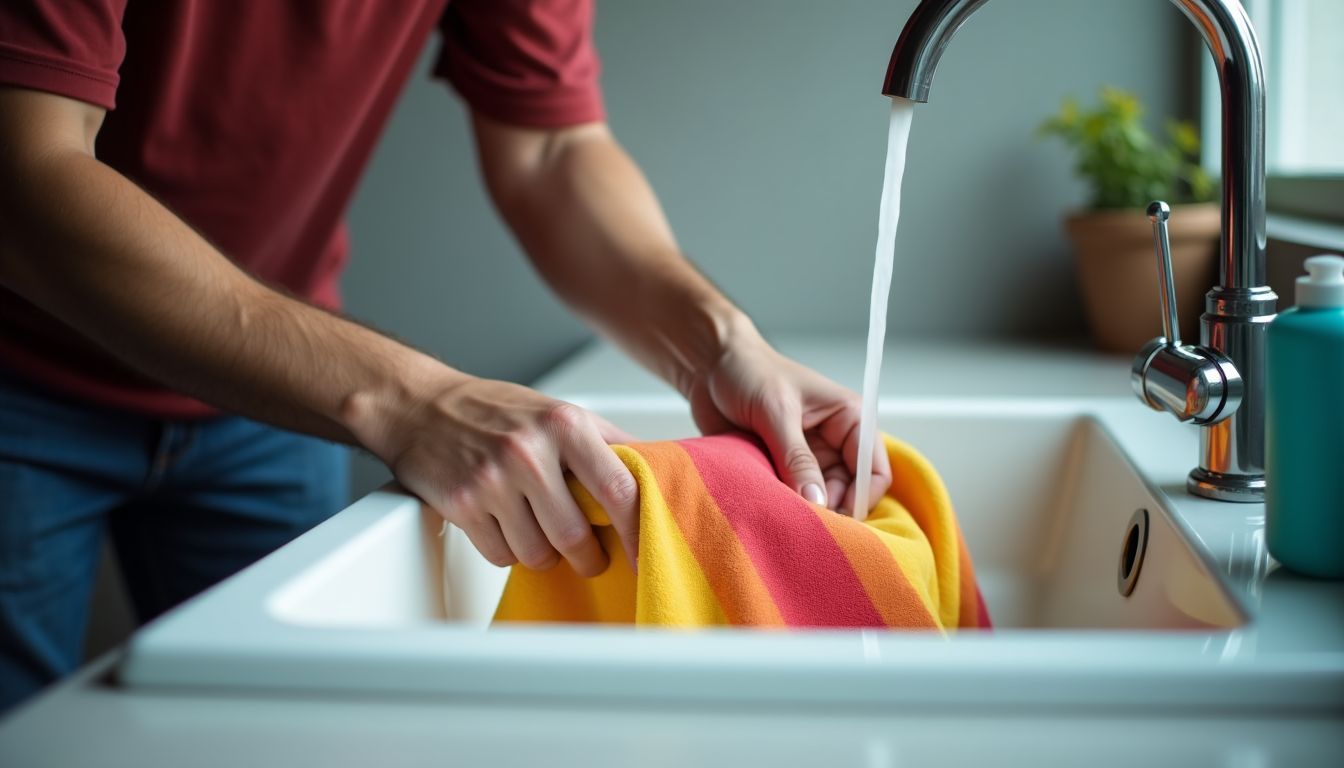Ever spent far too much time scrubbing windows only to find streaks and lint leftover? Many homeowners struggle with house cleaning tasks that seem simple but turn messy if done wrong. Understanding exactly what is microfiber cloth can help solve these household headaches.
One square inch of microfiber cloth packs around 200,000 tiny fibers that’s why it picks up dust and grime so effectively. This guide clearly explains how microfiber towels easily clean surfaces like glass or stainless steel without leaving behind annoying lint or ugly streaks.
Keep reading to finally achieve a spotless shine with less effort.
Key Takeaways
- Microfiber cloths contain around 200,000 tiny fibers per square inch, effectively trapping dirt and up to 99% of bacteria without needing harsh chemical cleaners.
- Made from polyester and polyamide, microfiber towels absorb seven times their weight in liquid, providing streak-free cleaning for windows, mirrors, stainless steel appliances, electronics screens, and even delicate lenses like Nikon or Canon cameras.
- Dry microfiber uses static electricity to attract dust particles easily; damp cloths quickly remove grease and grime without leaving lint or scratches behind ideal for auto detailing microfiber towels with products like Buff Pro Multi-Surface Microfiber Towels.
- To make these eco-friendly cleaning supplies last through hundreds of washes and reduce microplastic pollution (about 1.7 grams lost per laundry cycle), homeowners should wash them with mild detergent only without fabric softener and air-dry or use low heat settings on dryers.
What is a Microfiber Cloth?

Microfiber cloths are soft, durable cleaning fabrics made from tiny threads thinner than human hair. These clever fibers easily lift dirt and grime without leaving lint or scratches behind.
Definition of microfiber

Microfiber is a synthetic fiber with strands measuring one denier or less in thickness; each strand weighs just 1 gram for every 9,000 meters. This makes microfiber fibers extremely thin about one hundred times smaller than a strand of human hair and twenty times finer than silk.
Because microfibers are so tiny, microfiber cloths offer lint-free cleaning that easily traps dirt, dust, and bacteria without leaving streaks or scratches on surfaces. Homeowners looking to shift away from disposable rags can confidently choose eco-friendly cleaning microfiber towels to tackle everyday messes at home.
Key characteristics of microfiber cloths
Each square inch of microfiber cloth contains around 200,000 fibers made from polyester and polyamide. This dense blend picks up dirt, dust, bacteria, and liquids with ease. Microfiber towels can hold as much as seven times their weight in moisture.
The tiny split microfiber fibers grab particles effectively for lint-free cleaning results on surfaces like windows or stainless steel appliances.
Unlike regular cotton cleaning supplies, microfiber towels need no added detergents or fabric softener to perform well. They are reusable and eco-friendly alternatives to disposable paper products that add to waste piles and plastic pollution problems. These durable cleaning supplies also help reduce exposure to harmful chemicals at home since they remove grime using just water most times.
How Does Microfiber Work?

Microfiber acts like a magnet, attracting and capturing dust, grime, and germs. The tiny fibers have an electrostatic charge that pulls in debris instead of pushing it around.
Structure of microfiber fibers
Split microfiber fibers have a special design that traps dirt and liquid effectively. Each fiber splits into tiny strands much thinner than human hair often less than one decitex in thickness which boosts their ability to pick up dust, grime, and bacteria without harsh chemicals or cationic surfactants.
Polyester gives these textiles durability, while polyamide boosts absorption power for lint-free cleaning around the home or during auto detailing. The positively charged fibers attract dirt particles easily since most dust is negatively charged, providing premium microfiber products that offer reliable results every time.
Ability to trap dirt, dust, and bacteria
Lab tests confirm microfiber cleaning supplies remove up to 99% of bacteria from surfaces traditional materials reach only about 33%. These lint-free cleaning tools also hold onto grease and fat effectively, making household chores easier for parents who want safer home environments without harsh laundry detergents or fabric softener.
Microfiber towels help families minimize microplastic pollution in wastewater treatment sludge by reducing the need for disposable wipes and excessive chemicals often found in standard cleaning products.
Benefits of Using Microfiber Cloths

Microfiber cloths make cleaning quicker and easier, grabbing dirt and germs without leaving fuzz behind. Families love them because they’re gentle on surfaces and kinder to the planet than throwaway wipes or paper towels.
Watch this video demonstration on microfiber cleaning benefits
Superior cleaning performance
Microfiber towels easily beat traditional cleaning supplies by getting rid of dirt and germs more effectively. With split microfiber fibers, these towels trap about 99% of bacteria from surfaces, while regular materials capture only around 33%. Homeowners can rely on lint-free cleaning for spotless kitchen counters, bathroom sinks, and even auto detailing chores without leaving streaks behind.
For tougher messes demanding extra grit and strength around home and cars, exploring heavy-duty microfiber towels makes sense next.
Highly absorbent properties
A typical microfiber cloth easily holds up to seven times its weight in liquid, making it a star in the cleaning industry. Spills vanish quickly, leaving countertops and floors dry with just one swipe.
Split microfiber fibers soak liquids right away rather than pushing them around like regular rags or paper towels do. This powerful absorbency saves busy parents and homeowners from using multiple disposable items like rolls of paper towels.
Homeowners aiming for eco-friendly cleaning welcome this as an effective way to reduce waste while tackling everyday messes. Besides absorbing spills effectively, these handy lint-free cleaning cloths also trap moisture deep within their fibers until rinsed clean. Thanks to split microfiber designed for maximum absorption, damp surfaces are dried off without streaking or dripping issues.
Glassware shines bright again after polishing with premium microfiber products specially made for glass cleaning tasks. With such remarkable absorbent skills available at home, looking into extra benefits like streak-free and lint-free results becomes even more worthwhile!
Streak-free and lint-free results
Microfiber towels give windows and mirrors that clear, spotless look families love. The tiny split microfiber fibers trap dirt, dust, grease, and even bacteria without leaving streaks or lint behind.
Microfiber cloth can hold up to seven times its weight in liquid, making it a champ at soaking up water and cleaner sprays so surfaces dry completely clean. Ordinary cotton rags often leave fuzzy bits behind; premium microfiber products create smooth results that homeowners appreciate during glass cleaning chores around the home or for auto detailing tasks on cars.
Families who value eco-friendly cleaning methods also prefer these reusable towels over disposable wipes because they last long while reducing microplastic pollution. Next up are more reasons why microfiber offers an eco-friendly alternative to disposable cleaning supplies.
Eco-friendly alternative to disposable cleaning supplies
Disposable cleaning supplies add up quickly in both cost and waste. Switching to microfiber towels offers homeowners a planet-friendly choice, cutting down on daily trash while saving some cash.
These split microfiber cloths capture dirt effectively without harsh chemical cleaners, meaning fewer harmful substances enter drains and water systems, easing microplastic pollution problems too. Each cloth can handle hundreds of washes without losing quality or performance ideal for busy parents tackling mess after mess around the house. Homeowners choosing reusable premium microfiber products take simple steps toward greener living by reducing their impact on landfills and lowering dependence on single-use items common in today’s cleaning industry.
Types of Microfiber Cloths

Microfiber cloths come in all shapes and sizes, each one built for a different job read on to find out which type tackles your cleaning needs best.
All-purpose microfiber cloths
All-purpose microfiber cloths handle most household chores with ease. A great example is the 16″x16″ Buff Pro Multi-Surface Microfiber Towels, trusted widely in the cleaning industry for lint-free cleaning and strong absorbency.
These towels grab dust from shelves, scrub kitchen spills, or polish stainless steel surfaces seamlessly. Property-marked towels also help busy parents track towels used for tasks like auto detailing to avoid mixing grease-covered rags into family laundry piles.
Glass cleaning gets easier too since these premium microfiber products leave mirrors clear without streaking.
For tougher messes demanding extra grit and strength around home and cars, exploring heavy-duty microfiber towels makes sense next.
Glass and lens cleaning microfiber cloths
Glass cleaning microfiber cloths make lens and glass care easy and effective. Brands like ZEISS, Sinar, Nikon, and Canon market these lint-free towels to safely handle delicate surfaces such as camera lenses or smartphone screens without leaving scratches or streaks.
A quality option is the Microfiber Glass Cleaning Pack designed specifically for achieving crystal-clear results on household glass items like mirrors, windows, or even eyeglasses perfect for busy parents tired of seeing smudges everywhere they turn.
These premium microfiber products use split microfiber to trap tiny dust particles rather than just spreading dirt around—a lifesaver during spring cleaning routines. Choosing lens-specific cloths also means avoiding harsh abrasives or chemicals that can damage expensive electronics displays favored by kids glued to tablets all day long.
High-quality microfiber solutions also help families cut down plastic waste from disposable single-use wipes, supporting eco-friendly cleaning methods in routine home cleanup tasks.
Waffle weave microfiber towels
Waffle weave microfiber towels feature small, square pockets that look just like breakfast waffles. These little “waffles” trap moisture and dirt fast, making drying dishes quick and easy for busy parents or homeowners.
For household chores, the 16″x 24″ microfiber waffle towels perform great at wiping plates, glasses, pots and pans without leaving lint behind. The waffle design boosts absorbency and helps achieve streak-free results when drying glassware or polished stainless steel appliances.
Plus, they’re an eco-friendly cleaning alternative to disposable paper products because they wash up effortlessly in mild detergent just avoid fabric softener to reuse again multiple times with no drop in performance.
Heavy-duty microfiber towels
While waffle weave microfiber towels work great on delicate surfaces, heavy-duty microfiber towels handle tougher cleaning jobs like champs. Buff Detail Microfiber Towels, such as the 16″x 16″ Buff Pro from Microfiber Wholesale, stand out for their power and durability in auto detailing and tough household tasks.
These premium microfiber products trap dirt, grease, and grime better than cotton cleaning supplies or generic cleaning rags. Homeowners can rely on heavy-duty versions for deep-cleaning kitchen ovens, scrubbing bathroom tiles without scratching surfaces, or ensuring lint-free polishing of car bodies.
How to Use Microfiber Cloths for Cleaning

Microfiber cloths make wiping down surfaces a breeze, whether used dry or slightly damp. With the right method, homeowners can easily remove dust and grime without streaks or spots.
Using microfiber cloths dry
Dry microfiber cloths clean surfaces by pulling in dust and dirt using electrostatic charges. Tests show that split microfiber attracts even tiny particles, like bacteria and grease, without sprays or cleaners.
Homeowners find dry lint-free cleaning perfect for delicate electronics screens, TV displays, mirrors, and lenses as it prevents damage from liquids or scratches. Parents especially value auto detailing microfiber towels inside cars to capture crumbs, pet hair, and allergens easily trapped between seats.
Cleaning with microfiber cloths when wet
Microfiber towels become powerful tools for deep cleaning after soaking in water. A damp split microfiber cloth can swiftly pick up smudged dirt, grease, and even bacteria from household surfaces.
Microfiber materials absorb as much as seven times their weight in liquid, helping to easily clean spills without leaving lint or streaks behind. Homeowners can simply dampen premium microfiber products with plain water to tackle tough messes on kitchen counters or sticky fingerprints on doors and walls.
For an eco-friendly approach free of chemical sprays and disposable cleaning supplies, a wet waffle weave microfiber towel makes quick work of messy countertops and grimy bathroom fixtures.
To get spotless results with glass cleaning, lightly mist windows or mirrors before wiping them down with auto detailing microfiber towels; just make sure they aren’t soaked through to ensure streak-free success.
Rinsing the cloth regularly in clean water while working helps remove trapped dust particles effectively for continuous lint-free cleaning power around the home. Next up are practical tips for spotless window care using these versatile textiles.
Tips for streak-free window and glass cleaning
For spotless windows and mirrors, an effective tip is to use the Microfiber Glass Cleaning Pack. This pack offers lint-free cleaning to easily remove smudges without leaving streaks behind. Folding microfiber towels into fourths provides multiple clean sides during cleaning, making quick work of fingerprints on glass doors or toothpaste splashes on bathroom mirrors.
Skip strong chemical sprays; a simple water mist with split microfiber cloth clears away grime effortlessly while protecting family members from harsh fumes. Next up is how to keep those helpful cloths in great shape for continuous use through proper care and maintenance techniques.
Proper Care and Maintenance of Microfiber Cloths

Taking good care of microfiber towels helps them clean better and last longer keep reading for quick tips to get the most out of these handy cloths.
Washing microfiber cloths correctly
Homeowners and parents can wash microfiber towels easily with regular detergent in the washing machine. They should skip fabric softener, bleach, or dryer sheets since these products clog the split microfiber fibers that trap dirt and bacteria well.
Each laundry cycle releases about 1.7 grams (0.060 oz) of microfibers into water systems, adding to microplastic pollution; choosing an eco-friendly cleaning detergent is best for planet-loving homes.
To protect premium microfiber products from damage, homeowners need to set dryers on low heat or air dry them instead of using high temperatures. Excessive heat ruins cloth fibers over time and reduces their ability for lint-free cleaning across windows, mirrors, screens or stainless steel surfaces around family households.
Good care will also make auto detailing microfiber towels last longer without losing absorbency or causing scratches during car washes at home.
Avoiding fabric softeners and high heat
Fabric softeners might seem helpful for laundry, but they can damage microfiber cloth fibers. These chemicals coat the split microfiber fibers and block their ability to trap dirt. High heat is also harmful for microfiber towels.
Drying them on a hot setting can melt or warp the tiny polyester fibers, making them less effective. Microfiber cleaning supplies work best when air-dried naturally or dried on a low heat cycle. Setting dryers on gentle cycles protects these premium microfiber products and helps stop microplastic pollution in waterways too.
Proper storage is key to keeping microfiber towels working like new; here are some easy tips for storing right at home.
Storing microfiber cloths to maintain longevity
Keeping microfiber cloths far from fabric softener and high heat helps them clean well. Proper storage is just as crucial to keep the premium microfiber products working longer. A clean, dry place like a cabinet or drawer protects split microfiber from moisture and mold growth.
Separate auto detailing microfiber towels from household cleaning supplies to avoid mixing harsh chemicals with gentle fabrics. Placing labeled bins or baskets makes it easy for anyone in the family to grab lint-free cleaning cloths quickly without confusion or mess.
Common Uses for Microfiber Cloths

Microfiber cloths tackle daily grime from kitchen counters to smartphones without a hitch. They’re handy sidekicks around the house, car, and even when cleaning delicate gadgets.
Dusting and general household cleaning
Dusting shelves, tables, and household surfaces becomes easier with microfiber towels. These split microfiber fabrics trap dust particles like tiny magnets, giving lint-free cleaning results every time.
Dry cloths easily pick up pet hair from couches and dust from electronics screens without scratching delicate surfaces. Dampening the same towel makes grease removal on kitchen counters quick and sanitary by reducing bacteria better than cotton cleaning supplies or paper towels do.
Using these eco-friendly cleaning supplies saves money over disposable options thanks to durability for hundreds of washes—ideal for parents seeking practical solutions in busy homes.
Cleaning electronics and screens
Microfiber cloths handle delicate screens and electronics with care. Brands like Sinar, ZEISS, Nikon, and Canon market special microfiber towels for gentle lens cleaning tasks. The split microfiber fibers trap dust without scratching tablets or TVs.
But homeowners should take caution with high-tech coated screens; these ultra-sensitive surfaces can become damaged by rougher fabrics or heavy-duty microfiber towels. For safe, lint-free cleaning of devices such as smartphones or laptops, stick to premium microfiber products designed specifically for glass cleaning and electronic surfaces.
Polishing surfaces like glass, mirrors, and stainless steel
Polishing glass, mirrors, and stainless steel becomes simple with microfiber towels. For streak-free results on windows or bathroom mirrors, a Microfiber Glass Cleaning Pack gets the job done every time.
Buff Detail Microfiber Towels are perfect for stainless steel sinks and refrigerators, leaving them spotless without chemicals or lint residue. Homeowners can avoid disposable wipes by switching to this eco-friendly cleaning method that helps reduce microplastic pollution from the textile industry.
Auto detailing and car care
Keeping surfaces such as glass and stainless steel spotless matters, but cars deserve special attention too. Microfiber towels outrank traditional cotton cleaning supplies for auto detailing since they capture dirt and dust effectively without scratches or swirl marks.
Buff Detail Microfiber Towels stand out in the cleaning industry with their lint-free cleaning performance, ideal for polishing paintwork gently. Automotive covers and premium microfiber products further protect vehicles, keeping surfaces shiny clean while helping homeowners avoid microplastic pollution from disposable wipes.
Conclusion

Microfiber cloths change how homeowners clean their daily messes. These tiny fibers trap dust, dirt, and bacteria better than other cleaning supplies without chemicals or extra waste.
From lint-free window washing to auto detailing chores, households enjoy simpler cleaning jobs with fewer hassles. Easy care fits seamlessly into family routines just wash microfiber towels with mild detergent and skip fabric softener for longer use.
Microfiber makes green living easy while keeping homes fresher every day.
FAQs
1. What exactly are microfiber towels made from?
Microfiber towels contain tiny fibers, usually polyesters, woven into knits or non woven fabrics. Premium microfiber products often use split microfiber to trap dirt and dust effectively.
2. Why should I choose microfiber for lint-free cleaning tasks like glass cleaning?
Microfiber towels grab dirt without leaving behind annoying lint or streaks on surfaces like windows and mirrors. They’re a favorite in the cleaning industry because they make glass sparkle with less effort.
3. Can I use fabric softener when washing my auto detailing microfiber towels?
Skip the fabric softener—it coats fibers and reduces their ability to clean well. Instead, wash your property-marked towels separately to keep them fluffy and effective longer.
4. Are microfiber cloths an eco-friendly cleaning option despite microplastic pollution concerns?
Yes, they’re reusable many times over, reducing waste compared to disposable cleaning supplies that add more trash to landfills and worsen greenhouse effect issues. Just be mindful of proper care so fewer fibers end up as microplastic pollution down the drain.
5. Do dyes or flame retardants in colored microfiber wholesale products affect how safe they are around heat sources?
Most standard dyed cloths don’t have flame retardants added—they’re flammable if exposed directly to high heat or flames! Keep these colorful helpers away from open fires; stick strictly to regular household chores instead of risky adventures near hot stoves or grills!
6. What are some troubleshooting tips when using microfiber towels?
If streaks or lint appear during cleaning, ensure the towel is dampened properly and rinse it frequently to clear trapped particles. Replace older towels that have lost their split microfiber performance to maintain excellent lint-free cleaning results, especially for glass cleaning tasks.






